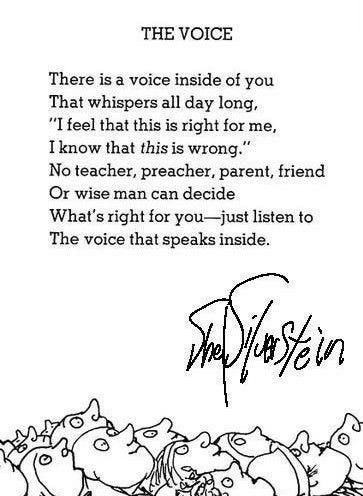Recently, my family attended a bar mitzvah where one of the readings was a Shel Silverstein poem called The Voice:1
There is a voice inside of you
that whispers all day long,
"I feel that this is right for me,
I know that this is wrong."
No teacher, preacher, parent, friend
or wise man can decide
what's right for you - just listen to
the voice that speaks inside.
The poem makes it sound relatively easy to tune into your inner wisdom: “Just listen to the voice that speaks inside.”
But it got me thinking…what if you can’t hear the voice?
After all, it’s only a whisper. The voices of teachers, preachers, parents, friends, and wise men (which are louder) can easily drown it out.
The first step in the decision-making framework my co-author and I share in Money and Love is to clarify what’s important to you, which requires tuning into the whisper.
Similar to the directive to “just listen to the voice that speaks inside,” it sounds relatively straightforward. But it’s not.
Based on questions I’ve gotten since my book came out — and my own experience — many of us need help tuning in to the whisper.
In this newsletter, a 10 minute read, you’ll learn:
Why some of us have a really hard time hearing the whisper;
3 surprising strategies to turn up the volume on the whisper; and
My #1 tip if you’re seeking to clarify what’s important to you
As a bonus, paid subscribers get an exercise to help them with the last bullet (that got rave reviews in my course on making big life decisions).

Why the whisper is quieter for some
Some people are experts at knowing who they are and what’s important to them.
For example, I just finished Haruki Murakami’s memoir What I Talk About What I Talk About Running. In it, the bestselling Japanese novelist who’s run more than two dozen marathons shares how running has influenced his work.
The book is peppered with comments such as, “The thing is, I’m not much for team sports. That’s just the way I am,” and “I think I’ve been able to run for more than twenty years for a simple reason: It suits me.”2
Murakami knows himself intimately and has used this self-knowledge to shape his career and life choices.
By way of explanation, he notes that much like a runner trying to beat a specific time, “a writer has a quiet, inner motivation, and doesn’t seek validation in the outwardly visible.”3
I love your work, Mr. Murakami, but I call BS on that.
I am a writer AND I absolutely seek validation in the outwardly visible.
Do I wish that weren’t the case? Of course.
I don’t know much about the Enneagram system of personality types, but a friend who does suggested I might be a Type Three. The description resonated.
Here’s what the Enneagram Institute has to say about Type Threes:
From their earliest years, as Threes become dependent on receiving attention from others and in pursuing the values that others reward, they gradually lose touch with themselves. Step by step, their own inner core, their “heart’s desire,” is left behind until they no longer recognize it…Threes report that when they realize to what extent they have adapted their lives to the expectations of others, the question arises, “Well, then, what do I want?” They often simply did not know; it was not a question that had ever come up before.4
Whether or not you believe in the validity of the Enneagram, I’d suggest that beyond mimetic desire and general social pressure, some of us are more susceptible to tuning into the voices of others because of our personalities.
I’ve had to learn the hard way how to turn the volume up on “the voice that speaks inside,” and now I want to share what I’ve learned with you.
Three strategies for tuning in
#1: Start small
Knowing your preferences on a small scale — like what kind of snack you’ll find most satisfying — can help you tune into your preferences for bigger things.
I don’t remember how I first came across the study that introduced me to the terms cruncher, chewer, sucker, and smoosher, but I do remember the context.
While driving to a hike in Tahoe, my family started discussing the candy we liked best (we find hikes go much more smoothly when we bribe let our kids eat candy).
It turned out we had different preferences: my older son likes to suck on lollipops and hard candies, whereas my younger son prefers chewy candies like gummy bears and Starbursts.
This puts them in different quadrants in the “mouth behavior” chart according to a study published in Food Science & Nutrition (see graphic below) .
Our kids were still quite young at the time (ages 5 and 7), so it was interesting to hear them articulate such clear preferences vs. saying they just didn’t like a food.
As for me? Absolutely a cruncher. Give me all the peanut M&Ms!
By leaning into your preferences on a low-stakes choice (like what to have for a snack), you see how satisfying it can be, which gives you the motivation and confidence to do it when it comes to higher-stakes choices.

#2: Pay attention to your body
If you’re experiencing new and unexplained physical symptoms, be open to the fact that it might be “the voice that speaks inside” trying to get your attention.
Now, I’m not a medical professional, and this is definitely not medical advice.
That said, I want to share how I learned the hard way that your body is the ultimate accountability partner. If you don’t listen to the whispers, it turns up the volume.
Three separate times in my life, I developed strange skin-related issues after periods of significant stress.
Two of these times, I saw doctors who diagnosed the issue and prescribed a treatment plan without any further discussion. One doctor, however, asked me if there was anything going on in my life that had recently changed or was especially stressful.
I looked at her, confused by the question, and acknowledged that in the last six months I had moved, started a new job, and gotten engaged. But I wasn’t convinced those things had anything to do with the itchy hives on my legs.
“Well,” she said with a raised eyebrow, “it’s all connected.”
I was 30 years old when I learned about the mind-body connection. I wish I could say I took action based on that information. But I didn’t. So my body got louder.
The next time my body tried to talk to me, I was 39.
I had a demanding full-time job; two young kids; and for six years, I had been navigating the ambiguous loss of my mother after her life-changing accident.
Despite all that, I wasn’t doing much for my own physical or mental well-being besides squeezing in an after-work yoga session or two each week.
That summer, I developed a fever along with a painful, strangely sensitive bump on my cheek. I saw a doctor, who diagnosed me with shingles.
My doctor mentioned that while shingles was rare for someone under 50, she’d diagnosed dozens of younger patients with the disease since she began practicing in the San Francisco Bay Area (which, despite the illusion of chill vibes, can be a high-pressure environment).
This time, I paid attention to the wake-up call. I made several changes, including seeing a therapist for the first time in my life.
#3: Make time to get quiet
Starting therapy was one of the ways I began to make time and space for my feelings, which I had pushed aside for many years while jumping through hoops.5
Earlier in my life I had been diligent about keeping a journal, but that practice had fallen away during the busy season of full-time work and young children (perhaps some of you can relate).
I started making time to write in my journal again, especially when I felt specific emotions that seemed useful to explore.
For example, I’d heard Gretchen Rubin note that envy can be a particularly instructive emotion, so every time I felt a twinge of jealousy about someone else’s accomplishments, I made time to write about it and tease out what that emotion might be telling me.
Your version of “getting quiet” may look different from mine, but making time to do it is critical. When we’re rushing around, it can be especially challenging to hear the whisper. So find a way that works for you to pause and explore what the voice might be telling you.
My #1 tip
My top tip if you’re seeking to clarify what you want? Identify your 3-5 core values.
You may have done this before, but values can and do evolve as you have new experiences and gain perspective, so it’s worth revisiting them regularly.
A good option is a simple online value sort exercise, or you can get fancy and order a card deck (I like this one with beautiful illustrations from Lisa Congdon).
I’ve developed a fun exercise inspired by March Madness to help you identify your values in an unexpected, playful way. I debuted it in a course I taught last year and it received rave reviews.
Paid subscribers can scroll to the end of this newsletter to access the exercise.
Why is knowing your values so powerful? Because values are guiding principles that represent what truly matters to you. They can serve as a compass, guiding you to live in a way that aligns with your deepest held beliefs.
If you’re not sure what your inner voice is saying, getting clear on your values is a great place to start.
Behind the Scenes
The Money and Love paperback is out in 2 weeks! One of my top values is relationships, and I’ve been having fun planning creative collaborations:
April 10: Myra Strober and I are teaming up with Professor Rosalind Chow for a virtual book talk for those who pre-order one or both of our books. Register here to learn how relationships and decisions shape opportunities for ourselves and others (and how to leverage yours for success).
April 30: San Francisco Bay Area folks: I’m joining forces with renowned coach Tara Mohr to speak at an amazing new space featuring books and wine, Book Society in Berkeley. You can buy tickets here for the event.
Anytime: I’ve been recording lots of podcasts with delightful hosts. Most episodes won’t come out until later, but you can listen to my conversation with Dr. Adam Dorsay of the award-winning podcast SuperPsyched here.
Deliberately yours,
Abby
Paid subscribers, get your bonus exercise below!





